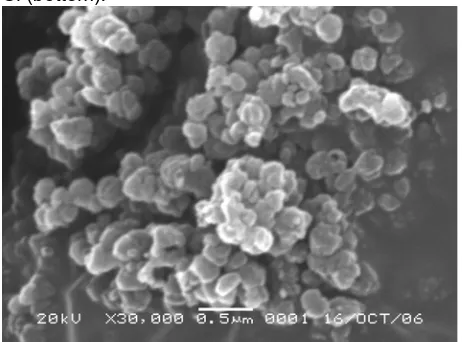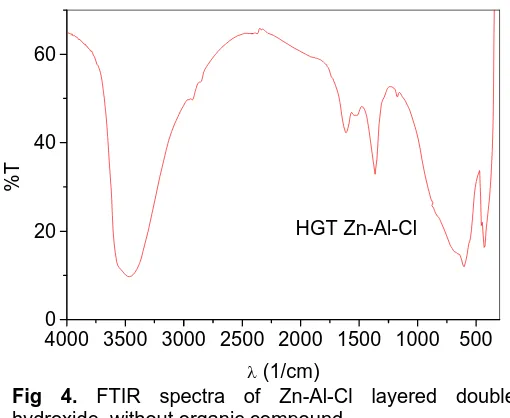Indo. J. Chem., 2007, 7 (1), 1 - 4 1
Zn-Al LAYERED DOUBLE HYDROXIDE AS HOST MATERIAL FOR
SUNSCREEN COMPOUND OF p-AMINOBENZOIC ACID
Roto 1,*, Iqmal Tahir 1, and Mustofa 2
1
Department of Chemistry, Faculty of Mathematics and Natural Sciences Universitas Gadjah Mada, PO Box BLS 21 Yogyakarta, Indonesia 55281
2
Department of Pharmacology, Faculty of Medicine, Universitas Gadjah Mada, Yogyakarta, Indonesia 55281
Received 17 December 2006; Accepted 2 January 2007
ABSTRACT
Zn-Al layered double hydroxide can be used as host material for UV active compound p-aminobenzoic acid (PABA), which is having capability to block UV light of sunlight. The formation of Zn-Al-PABA was best developed in
which the nucleation process was done at room temperature and followed by hydrothermal treatment at 100 oC. To
make a better product, the molar ratio of Zn to Al to PABA was adjusted to 3:1:1. From the elemental analysis and
the content of PABA, it was observed that the product has structural formula of Zn0,745Al0.254(OH)1.650(PABA)0.349.
0.684H2O. The particle size of the powder as estimated using SEM was in the range 100-200 nm. FTIR and XRD
proved that the p-amino benzoate ion occupied the interlayer space. This material is expected to have high sun protection factor (SPF).
Keywords: layered double hydroxide, sunscreen, p-amino benzoic acid, nanoparticle.
INTRODUCTION
Layered double hydroxides (LDHs), also known as
hydrotalcites and anionic clays, consist of MII(OH)6 and
MIII(OH)6 edge-sharing octahedrons forming sheets
similar to those of brucite [1]. The net positive charges on the sheets are balanced by exchangeable anions occupied the interlayer space [2-5]. For instance, the mineral known as hydrotalcite is a Mg-Al LDH in which
CO3
is charge balancing anions in the interlayer space
so that it is formulated as Mg6Al2(OH)16·CO3·4H2O [6,7].
LDHs have been studied extensively for many possible applications such as anion exchangers, acid scavengers, polymer additives, battery cathodes, catalysts, catalyst supports, electrode modifiers, etc. [5-12].
In the recent years, layered double hydroxides have been studied extensively for possible application in drug delivery system, organic-inorganic composite materials, and so on [1]. In this work, an organic-inorganic sunscreen will be prepared from Zn-Al-Cl LDH. Food and Drug Administration (FDA) has issued a list of
chemicals in sunscreens in which TiO2 and ZnO can
comprise up to 20% of total weight and PABA up to 15%. Most organic sunscreens consist of benzene ring as main chromophoric subunit and other substituents such as carbonyl. The combination of them produces sun screening effect since in the UV range, where the compound will absorb the light at low wavelength and then release those high wavelengths. LDHs have net positive charge layer that must be balanced with the interlayer anion. If the sunscreen compound bearing negative subunit such as sulphonate and carboxylate, they can occupy the interlayer space the way charge
balancing ions do, creating organic-inorganic composite of sunscreen. Organic-inorganic sunscreen is not only safe but also reduce the amount of the UV active compounds. The LDH can act as physical blocking and UV active compound will provide chemical blocking. Further, the product is also expected to have small particle size in the range of 50-200 nm. In this paper, we wish to report the preparation, characterization, and morphology of Zn-Al-PABA prepared from corresponding zinc chloride, aluminium chloride and p-amino benzoic acid. Since ZnO and
Al2O3 have been found extensively in various topical
drugs, the Zn-Al-PABA is also expected to have high biocompatibility.
EXPERIMENTAL SECTION
Zinc and aluminium salts were obtained from Merck and are of analytical grade chemicals. P- benzoic acid (PABA) was also a pure chemical and other chemicals obtained from Merck used as received.
Zn-Al-Cl LDH was prepared according procedure in the literature [11]. Synthesis of the Zn-Al-PABA from zinc and aluminium chlorides was performed in a three-necked round flask. A 25.0 mL aqueous solution of 0.60 M (15.0 mmol) was mixed with 25.0 mL aqueous solution of 0.20 M (5.0 mmol) aluminium chloride and stirred quickly at about 1000 rpm using a magnetic stirrer. To this mixture, a 50.0 mL solution containing 10.0-mmol sodium p-amino benzoate (Na-PABA) was added using a funnel and stirred quickly. Na-PABA was prepared prior to the mixing by stoichiometric reaction of PABA with NaOH. It took about 2 minutes to complete the addition of Na-PABA.
* Corresponding author. Tel/Fax : 0062-274-545188 Email address : [email protected]
Indo. J. Chem., 2007, 7 (1), 1 - 4 2
0 10 20 30 40 50
0 Then, the slurry was hydrothermally heated in a
PTFE bottle at 100oC for 15 hours. The product was
separated using centrifuge and repeatedly washed three times using double distilled water. The collected solid
was dried in an oven at 70 oC for 48 h. After being dried,
its layered structure was confirmed using X-ray Diffraction (XRD) on Shimadzu 6000 series. The metal contents were determined using atomic absorption spectrometry (AAS) using appropriate standard solution. The amount of water is determined gravimetrically using porcelain crucible container after the sample was heated
at 180 oC for 3 h. The PABA in the interlayer space was
recovered by reacting the solid with dilute nitric acid. PABA was separated to become solid since other metal components were dissolved. The results of the elemental analysis were used to determine the structural formula of the product [6].
The morphology of the solid was scanned using scanning electron microscope (SEM).
500
RESULT AND DISCUSSION
From the results of elemental analysis, the structural formula of synthesized Zn-Al-PABA is Zn0.745Al0.254(OH)1.650 (PABA)0.349.0.684H2O. Note that
the water content was determined gravimetrically after
heating at 180oC for 3 h. Metal were determined using
atomic absorption spectrometry (AAS). The formulae are fit to the general structure of layered double hydroxide of
[M2+1-xM
is expected the structural formula is very close to the ideal structure of hydrotalcite.
The PABA content was slightly higher, however, meaning that some of PABA may be included in the interlayer space and form ionic bonding between PABA and zinc or aluminium. For ideal structure, aluminium
Fig 2. Microscopic view of Zn-Al-PABA powder (prepared from zinc chloride and aluminium chloride) recorded using SEM at magnification of 20,000 X. As seen in the image the diameter of the particle approximately 100-200 nm.
should have equal molar to the anion. In the structure, the charge balance should be maintained in which zinc, aluminium, hydroxide, and PABA are contributing. This product shows that it is confirmed to the layered doubled hydroxide structure.
Fig 1 shows the XRD pattern of the Zn-Al-PABA prepared from the salts of zinc chloride and aluminium
chloride. The d003 of the product was 11.77 Å
(corresponding to 2θ = 7.5o). For comparison purposes,
the d003 of the Zn-Al-Cl where no organic compound
are present is 7.80 Å [11]. The net increase of nearly 7.40 Å is attributed to the replacement of small anion of chloride with p-amino benzoate.
The scanning electron microscopy (SEM) image of the product is shown in Fig 2 and Fig 3.
The particle size can be estimated from the image which is about 100-200 nm. Besides having nano size, the powder also shows uniform particle size. No
Fig 1. XRD pattern of Zn-Al-PABA LDH (prepared from zinc chloride and aluminium chloride) (top) and Zn-Al-Cl (bottom).
Fig 3. Microscopic view of Zn-Al-PABA powder (prepared from zinc chloride and aluminium chloride) recorded using SEM at magnification of 30,000 X. As seen in the image the diameter of the particle approximately 100-200 nm.
Indo. J. Chem., 2007, 7 (1), 1 - 4
Roto, et al.
3
4000 3500 3000 2500 2000 1500 1000 500
0
4000 3500 3000 2500 2000 1500 1000 500 0
Fig 4. FTIR spectra of Zn-Al-Cl layered double hydroxide, without organic compound.
particle size larger than 200 nm or smaller than 100 nm was observed, indicating that the product is quite homogeneous in size.
Xu et al. have reported that small particle size can be achieved by hydrothermal treatment of the layered double hydroxide slurry after the nucleation process was completed [12-13]. They had successfully prepared plain Zn-Al and Mg-Al LDH with the particle size around 50 nm. Their LDHs do not have organic compound inside the interlayer space. In this work, with PABA in the interlayer space we can manage to prepare LDH with the particle size about 100-200 nm, reasonably low. Note, however, that our method of LDH preparation is very simple. The Zn-Al-PABA can be produced by
adjusting the concentration of Zn2+, Al3+, and PABA. pH
adjustment during the synthesis was not necessary, since the product can be achieved easily. Adjusting the solution pH during the preparation is usually difficult and time consuming.
Figure 4 shows FTIR spectra of native Zn-Al-Cl layered double hydroxide without p-aminobenzoic acid. As expected, the vibration mode of O-H stretching is
seen at 3500 cm-1. The corresponding vibration mode of
O-H bending is observed at 1630 cm-1. The presence of
trace carbonate ion in the interlayer space is also
detected at near 1360 cm-1. Zn-Al-Cl layered double
hydroxide is formed by mixing zinc chloride and
aluminium chloride with NaOH. Atmospheric CO2 reacts
with the mixture to produce the impurity.
After p-aminobenzoic acid was inserted into the interlayer space of Zn-Al-Cl layered double hydroxide, the FTIR spectra of the product was, once again, recorded. Figure 5 shows FTIR spectra of Zn-Al-PABA
Fig 5. FTIR spectra of Zn-Al-PABA layered double hydroxide (prepared using chloride salts).
λ (1/cm)
layered double hydroxide. A band of O-H stretching is
seen at 3452 cm-1, in which related O-H bending is not
observed at 1630 cm-1, probably overlaid by other
bands. The N-H stretching is very close to O-H
stretching, which is observed at 3213 cm-1. Further,
C-H stretching of the aromatic ring can be confirmed with
the band at 3124 cm-1. The C=C vibration of the
aromatic ring (benzene) is also supported by the
vibration at 1419 cm-1and 1566 cm-1, respectively. The
band near 1608 cm-1 correspond to the C=O vibration
mode. In addition, the C-H bending of aromatic ring is
also clearly recorded at 710 cm-1.
From the XRD, elemental analysis, and FTIR it is convincing that the product is Zn-Al-PABA. The nanosize particle as recorded using SEM proved that the product has a narrow particle size between 100-200 nm, confirming that nanosize Zn-Al-PABA can be prepared at very mild condition. Unlike what was reported before the hydrothermal treatment [12] and rigorous mixing using colloid mill [14] were not necessary to prepare nanosize Zn-Al-PABA.
CONCLUSION
Indo. J. Chem., 2007, 7 (1), 1 - 4 4
ACKNOWLEDGEMENT
We are indebted to Mr. Wikanda, Laboratory of Quartenery Geology, Department of Minerals and Natural Resources, Bandung, Indonesia for recording SEM images. The Office of Ministry of Research and Technology (KMNRT) who provides most of the financial support was greatly appreciated. Our special thanks go to our students who helped prepare the LDHs.
REFFERENCES
1. V. Rives, Ed., 2001, Layered Double Hydroxide: Present and Future, Nova Science Publishers, Inc., New York.
2. E.D. Dimotakis, and T.J. Pinnavaia, 1990, Inorg.
Chem., 29, 2393.
3. V. Rives, and M.A. Ulibarri, 1999, Coord. Chem.
Rev., 181, 61.
4. S.P. Newman, and W. Jones, 1998, New J. Chem., 105.
5. de Roy, C. Forano, K. El Malki, J-P. Besse, 1992, in: M.L. Ocelli, H. Robson (Eds.), Expanded Clays and Other Microporous Solids, VNR, New York, p.108.
6. Roto and G. Villemure, 2006, J. Electroanal. Chem. (in press).
7. Roto and G. Villemure, 2006, Electrochim. Acta 51, 2539.
8. Roto, L. Yu and G. Villemure, 2006, J. Electroanal.
Chem. 587, 263.
9. Roto and G. Villemure,. 2006, J. Electroanal.
Chem., 588, 140.
10. Roto, A. Yamagishi and G. Villemure, 2004, J.
Electroanal. Chem., 572, 101.
11. Roto and G. Villemure, 2002, J. Electroanal.
Chem., 527, 123.
12. Z. Xu, G. Q. Lu, 2005, Chem. Mater 17, 1055. 13. Z. Xu, G. Stevenson, C-Q. Lu, G. Q. Lu, P.
Bartlett, P. Gray, 2006, J. Am. Chem. Soc. 128, 36.

